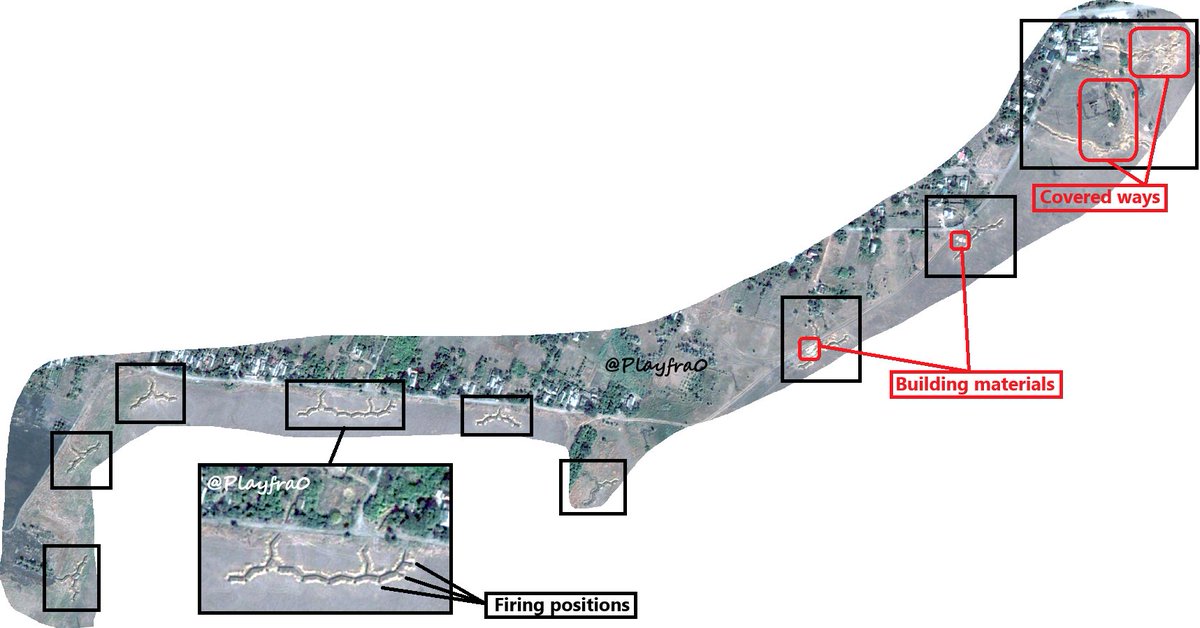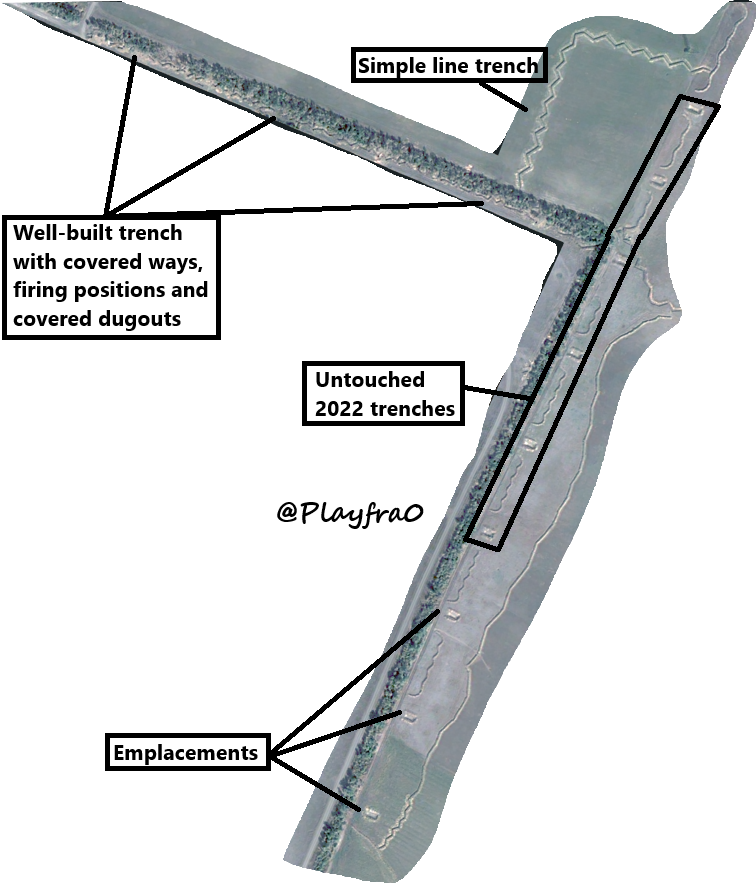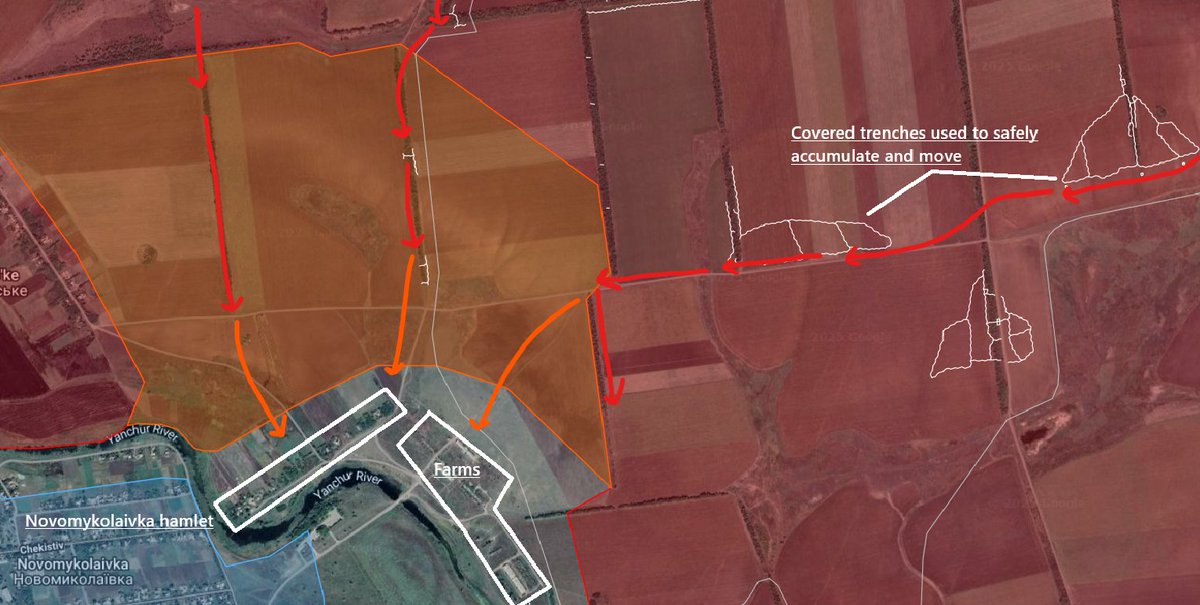1/🧵
#Kurakhove. What is happening right now?
With this thread, I'm aiming to analyze the current situation near and around this crucial city, with the added help of high-res satellite imagery (sept. 2) showing the many trench networks defending the town.
#Kurakhove. What is happening right now?
With this thread, I'm aiming to analyze the current situation near and around this crucial city, with the added help of high-res satellite imagery (sept. 2) showing the many trench networks defending the town.

2/🧵
Kurakhove is a medium-sized town (18,220 pre-war population) with an area 1.8x Selydove's and 6x Novohrodivka's. The heart of this city is undoubtedly its many industrial areas. Through the town passes the Pokrovs'k - Donets'k railway, while north is a very big reservoir.
Kurakhove is a medium-sized town (18,220 pre-war population) with an area 1.8x Selydove's and 6x Novohrodivka's. The heart of this city is undoubtedly its many industrial areas. Through the town passes the Pokrovs'k - Donets'k railway, while north is a very big reservoir.

3/🧵
The town has been targeted by Russia ever since the start of the war. After Mar'yinka's fall, the Russians characteristically used mechanized columns to capture Heorhiivka and Maksymil'yanivka (with catastrophic losses) and are now in the city's administrative borders.
The town has been targeted by Russia ever since the start of the war. After Mar'yinka's fall, the Russians characteristically used mechanized columns to capture Heorhiivka and Maksymil'yanivka (with catastrophic losses) and are now in the city's administrative borders.

4/🧵
Currently, the Russians are expanding their contact line with the city's first line of defense but are most critically endangering its northern supply lines by attacking Sontsivka, finally aiming to capture Stari Terny and eventually Dachne, where the main supply road is.
Currently, the Russians are expanding their contact line with the city's first line of defense but are most critically endangering its northern supply lines by attacking Sontsivka, finally aiming to capture Stari Terny and eventually Dachne, where the main supply road is.

5/🧵
The frontal (eastern) part of the city is protected by two 2015 trench rings, which we will look at more in-depth soon, and by some trench lines dug adjacent to treelines, which can be very extensive especially in the southern sector of the town's defensive works.
The frontal (eastern) part of the city is protected by two 2015 trench rings, which we will look at more in-depth soon, and by some trench lines dug adjacent to treelines, which can be very extensive especially in the southern sector of the town's defensive works.

6/🧵
Here's the northernmost 2015 trench ring. You can clearly see that it has been left untouched since mid-2022 (picture #1's date). The only reinforcements it has received are two new covered dugouts/firing positions and a new communication trench.
Here's the northernmost 2015 trench ring. You can clearly see that it has been left untouched since mid-2022 (picture #1's date). The only reinforcements it has received are two new covered dugouts/firing positions and a new communication trench.

7/🧵
The northern 2015 ring was better upgraded. We can clearly see a whole second trench being built adjacent to the first on the ring's eastern circumference, as well as new covered and partly covered trenches and two communication trenches. Many firing positions are present.
The northern 2015 ring was better upgraded. We can clearly see a whole second trench being built adjacent to the first on the ring's eastern circumference, as well as new covered and partly covered trenches and two communication trenches. Many firing positions are present.

8/🧵
Kurakhove's eastern outskirts are also known for being defended by many T-shaped trench systems. The easternmost ones present a good number of firing positions and some covered ways, while many others have no covered ways at all.
Kurakhove's eastern outskirts are also known for being defended by many T-shaped trench systems. The easternmost ones present a good number of firing positions and some covered ways, while many others have no covered ways at all.

9/🧵
Staying in the eastern sector, here's what I meant by "trenches dug adjacent to treelines". This one in particular seems decently built. We can observe some firing positions and parts of the trench going under the foliage, though it won't be present in the winter months.
Staying in the eastern sector, here's what I meant by "trenches dug adjacent to treelines". This one in particular seems decently built. We can observe some firing positions and parts of the trench going under the foliage, though it won't be present in the winter months.

10/🧵
Let's move south, where we can see a completely different style. This is a very big but extremely primitive system, presenting simple trenches (no covered ways, firing positions or dugouts) connected by a single communication line. Some parts, at least, go under the trees.
Let's move south, where we can see a completely different style. This is a very big but extremely primitive system, presenting simple trenches (no covered ways, firing positions or dugouts) connected by a single communication line. Some parts, at least, go under the trees.

11/🧵
In the same general area we start seeing what I call "2022-styled trenches": a simple trench with an emplacement on both sides. These 2022 trenches were later reinforced with some simple trenches near and around and with some well built ones that you can see on the left.
In the same general area we start seeing what I call "2022-styled trenches": a simple trench with an emplacement on both sides. These 2022 trenches were later reinforced with some simple trenches near and around and with some well built ones that you can see on the left.

12/🧵
Here's an example of an irregular-shaped trench. This picture was taken between the frontal and south-eastern defense sectors of the town.
Here's an example of an irregular-shaped trench. This picture was taken between the frontal and south-eastern defense sectors of the town.

13/🧵
That's what I call the "Dal'nye sector". It is situated in the southernmost sector and it's like an appendix of the defense systems. It is characterized by T-shaped trenches all interconnected by a single line (you can see them the easiest on the treeline on the left).
That's what I call the "Dal'nye sector". It is situated in the southernmost sector and it's like an appendix of the defense systems. It is characterized by T-shaped trenches all interconnected by a single line (you can see them the easiest on the treeline on the left).

14/🧵
Here we come, southern sector. This area is characterized by interesting ring-shaped trench systems. Have you noticed the 2022-shaped trenches, if you remember?
In general, here we observe a mix of trenches under foliage, simple and 2022 trenches.

Here we come, southern sector. This area is characterized by interesting ring-shaped trench systems. Have you noticed the 2022-shaped trenches, if you remember?
In general, here we observe a mix of trenches under foliage, simple and 2022 trenches.


15/🧵
Let's sum this up. Most trenches may seem like they're well-built, but unfortunately they aren't considered as such against Russian tactics, but rather against an army that has more consideration for its manpower and resources in general.
Let's sum this up. Most trenches may seem like they're well-built, but unfortunately they aren't considered as such against Russian tactics, but rather against an army that has more consideration for its manpower and resources in general.
16/🧵
Don't get me wrong, there are still a number of well-built trenches here, but it is simply not enough coupled with massive Russian pressure and Ukrainian manpower issues, which I'll never say it enough times, is way more important to solve than digging trenches!
Don't get me wrong, there are still a number of well-built trenches here, but it is simply not enough coupled with massive Russian pressure and Ukrainian manpower issues, which I'll never say it enough times, is way more important to solve than digging trenches!
17/🧵
We must also take into consideration the operational situation: Russian attacks on Sontsivka are dangerous, if Kurakhove falls the Ukrainians will have to fall back in the best case scenario to the yellow line at Dachne and Shevchenko, rendering useless the trenches east
We must also take into consideration the operational situation: Russian attacks on Sontsivka are dangerous, if Kurakhove falls the Ukrainians will have to fall back in the best case scenario to the yellow line at Dachne and Shevchenko, rendering useless the trenches east

18/🧵
On this topic I will most certainly post a much more focused analysis, as this one was aimed to only analyze Kurakhove. In conclusion, I really hope you learned something new with this thread and that you liked it. Thanks very much for your attention! :)
On this topic I will most certainly post a much more focused analysis, as this one was aimed to only analyze Kurakhove. In conclusion, I really hope you learned something new with this thread and that you liked it. Thanks very much for your attention! :)
• • •
Missing some Tweet in this thread? You can try to
force a refresh
























